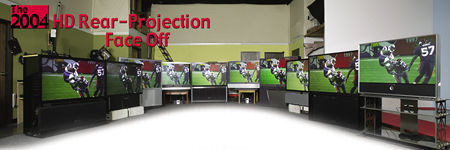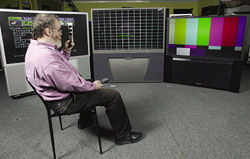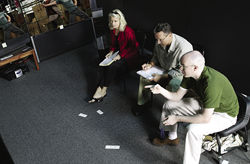The 2004 HD Rear-Projection Face Off
I blame myself. Two years ago, I was strapped into a 767 surrounded by screaming babies, seat-kicking toddlers, and former senior technical editor Mike Wood. We were on our way to CEDIA, and Primedia was nice enough to book us first class. No wait, that's a lie. We were in steerage. At one point, I innocently turned to Mike and mentioned that we had several rear-projection TVs at our Woodland Hills studio and maybe we should have a Face Off. I recognized the look that crept onto Mike's face. I tried to bolt, but there's only so far you can get when there's a seatback 3 inches from your kneecaps. (Sorry to whomever was sitting in front of me.)

Soon the studio was filled (I mean literally filled) with huge rear-projection TVs. Like an addict, Mike couldn't stop ordering TVs. I soon began to recognize the malicious giggle that he'd emit whenever he got someone new to participate.
Well, here it is, two years later. With Mr. Wood's departure, the task of compiling our somewhat biannual RPTV Face Off has fallen to me. Would I make it easy for myself and order just a handful of TVs? No chance. Perhaps the TV-ordering addiction is contagious. Somewhere, Mike Wood is laughing. I know. He called me so that I could hear him.
How?
Setting up 10 TVs is no small task, so video technical editor Scott Wilkinson (see photo, above) and I left the confines of our comfy listening room to the vast expanse of our photo studio. Here we could set up all of the TVs at once and see them all side by side (by side by side. . .). Key Digital supplied us with one of their KD-CDA12/
 HD View12 video-distribution amplifiers. Ten 8-meter component cables from Monster Cable sent the signal out to the TVs. We arranged said TVs in a horseshoe shape so that you could see each one with minimal effort.
HD View12 video-distribution amplifiers. Ten 8-meter component cables from Monster Cable sent the signal out to the TVs. We arranged said TVs in a horseshoe shape so that you could see each one with minimal effort.
We tested each TV's DVD performance using an interlaced signal from Onkyo's DV-SP800 player. HD material consisted of off-air signals recorded by a Zenith HDR230 hard disc recorder. To cut down on the glare that the TVs created, we set up nonreflective boards in the middle of the horseshoe. This created seating positions that were a little too close to most of the TVs; so, at the end of each day, we removed the boards and let everyone see the TVs from the correct viewing distance.
For the first day of the Face Off, we set up every TV using only the user menus and a copy of Video Essentials. Because most people think a brighter picture is better, we matched each TV's light output as close as possible using our Photo Research PR-650. This removed some of the possible bias toward the brighter fixed-pixel units and evened the playing field as best as possible for a test like this.
It's not entirely fair, though; so, for the second day of the Face Off, we let every TV run free. We calibrated each one (that we could calibrate) using the PR-650 and set them up to look their best. If that meant the TV was putting out 100 foot-lamberts and still looked good, so be it. We did most of the testing with the lights off; however, toward the end of each day, we brought up the lights so that everyone could see how the TVs looked in a well-lit room. Each reviewer ranked each TV in order each day.
 Who?
Who?
We got in five CRT TVs, three DLPs, and two LCDs. We had hoped to include an LCOS TV, but it wasn't ready in time. Four of the displays were full-on HDTVs, with built-in tuners. Screen sizes ranged from 46 to 65 inches, and prices spanned from $3,300 to $5,000. I brought in 12 eyes with their owners attached: Editor Maureen Jenson, executive editor Adrienne Maxwell, audio editor Chris Lewis, copy editor Amy Carter, and contributors Jerry Kindela and Glenn Fields.
What?
I used three selections for both DVD and HD material. For DVD, I started with The Fifth Element, which is good for colors, contrast, and shadow detail. Next, I used Toy Story 2 for color and video noise and Gladiator for shadows, black level, and video processing. For HD, I used a clip from ABC's November 3rd Monday Night Football game (go Patriots!) for color and detail; an episode of Without a Trace for shadows, black level, and noise; and an episode of CSI: Miami for color and contrast. Without a Trace and CSI are on CBS, which airs a 1080i signal.
Get on With It.
With a test setup that was as fair as it could be, we were off. Without further ado, I present Home Theater's 2004 HD RPTV Face Off.
- Log in or register to post comments






























































